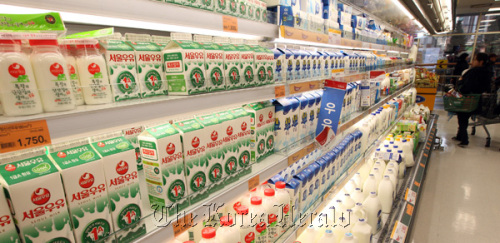On Thursday afternoon, Jeong Hyun-sook, a 55-year-old housewife, belatedly realized she did not have enough milk for breakfast.
She rushed to a nearby supermarket but all she could find was organic milk, which was almost twice the price of ordinary milk.
“A clerk said that the milk shelf often becomes empty earlier than usual recently. I was just stunned,” she said.
Jeong eventually bought two 200-milliliter milk cartons at a convenient store on the day. “I also couldn’t find the 1 liter carton that I usually buy even there.”
 |
Consumers pass by a milk products grocery shelf in Seoul on Friday. (Yonhap News) |
The milk shortage is a growing headache for consumers here following the outbreak of foot-and-mouth disease early this year.
The Korean government culled nearly 150,000 heads of cattle in order to curb the deadly animal disease. Of them, 36,000 were milk cows, prompting a 10 to 15 percent decrease in milk production.
The temporary shortage seemed to be eased with the suspension of school supply as most schools went on a summer vacation last week.
But now another problem has emerged ― scorching weather, which affects the stress level of dairy cows and their milk production.
Cows usually produce milk when the temperature is between 5 and 24 degrees Celsius. However, if the temperature exceeds 27 degrees Celsius, they lose their appetite while expending more energy, leading to a decline in milk production.
A recent heat wave has already reduced milk production by 5 to 10 percent compared to the same period last year.
Industry sources expect that this year’s milk production will be down almost 20 percent from last year.
“After the foot-and-mouth disease subsided in recent months, the shortage level remained at 7 percent last month. However, milk supply became unstable again recently,” said an official of a local major retailer.
“It would take two to three years for the decreased number of cows to recover back to normal. Until then, it seems unavoidable temporary milk shortage repeats like this.”
Milk-producing companies were also concerned about potential chaos in September when students head back to school. In preparation for it, they have already changed their marketing policy focusing more on flavored milk, which uses less raw milk.
By Lee Ji-yoon (
jylee@heraldcorp.com)








